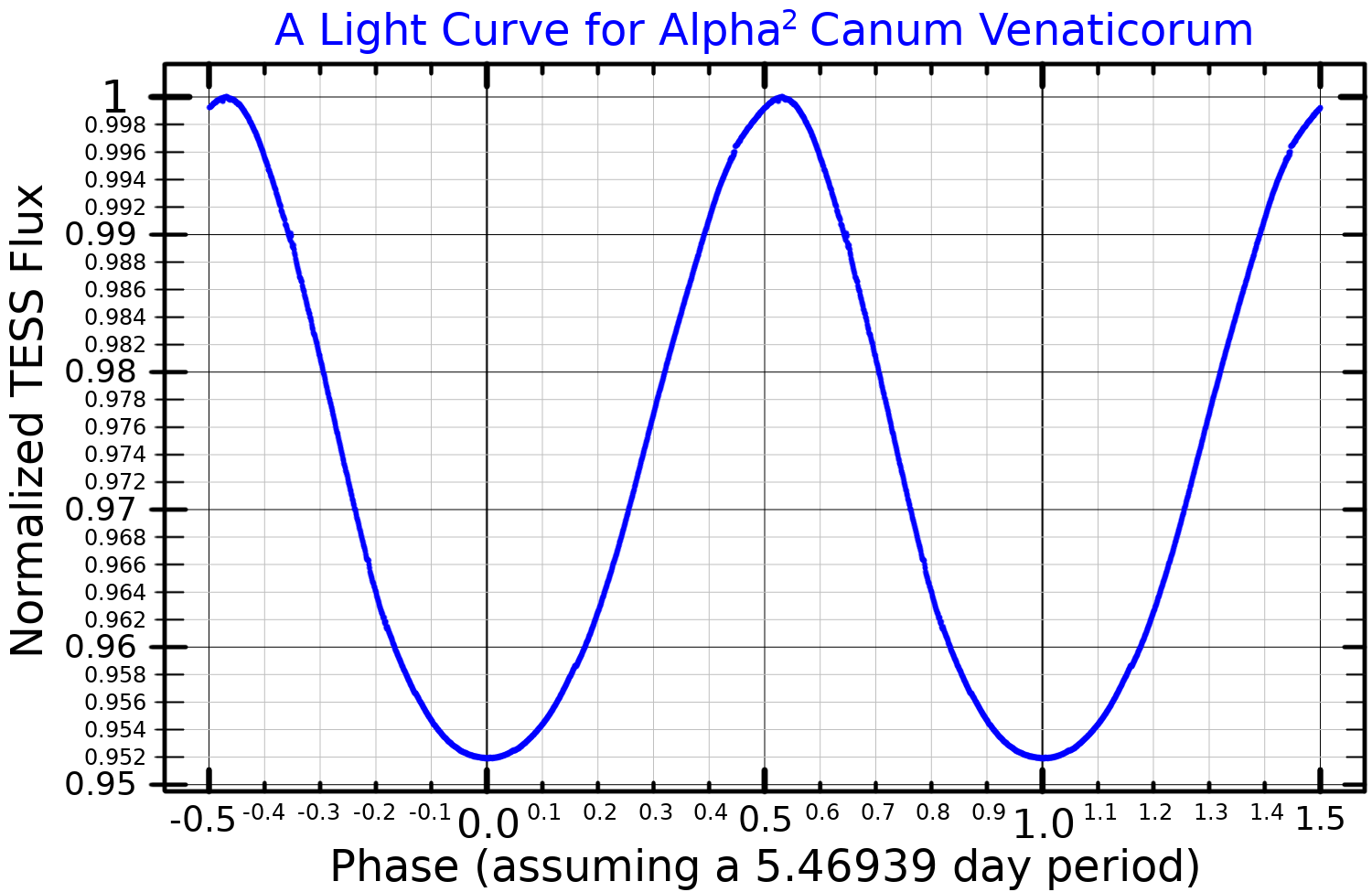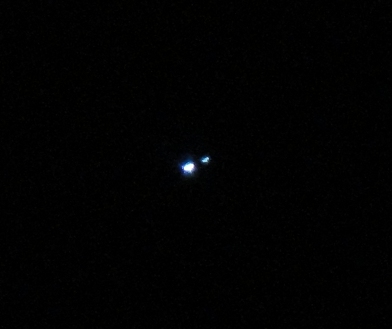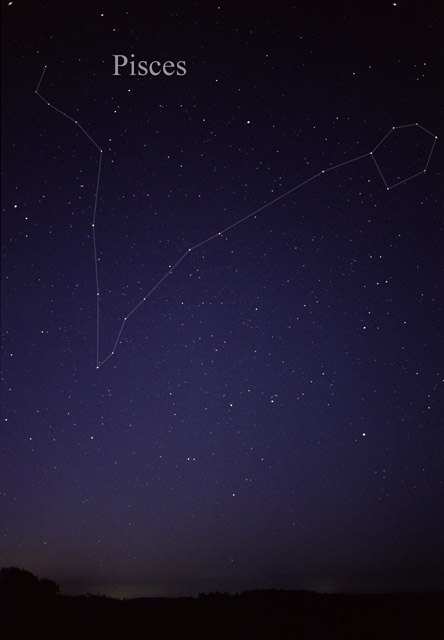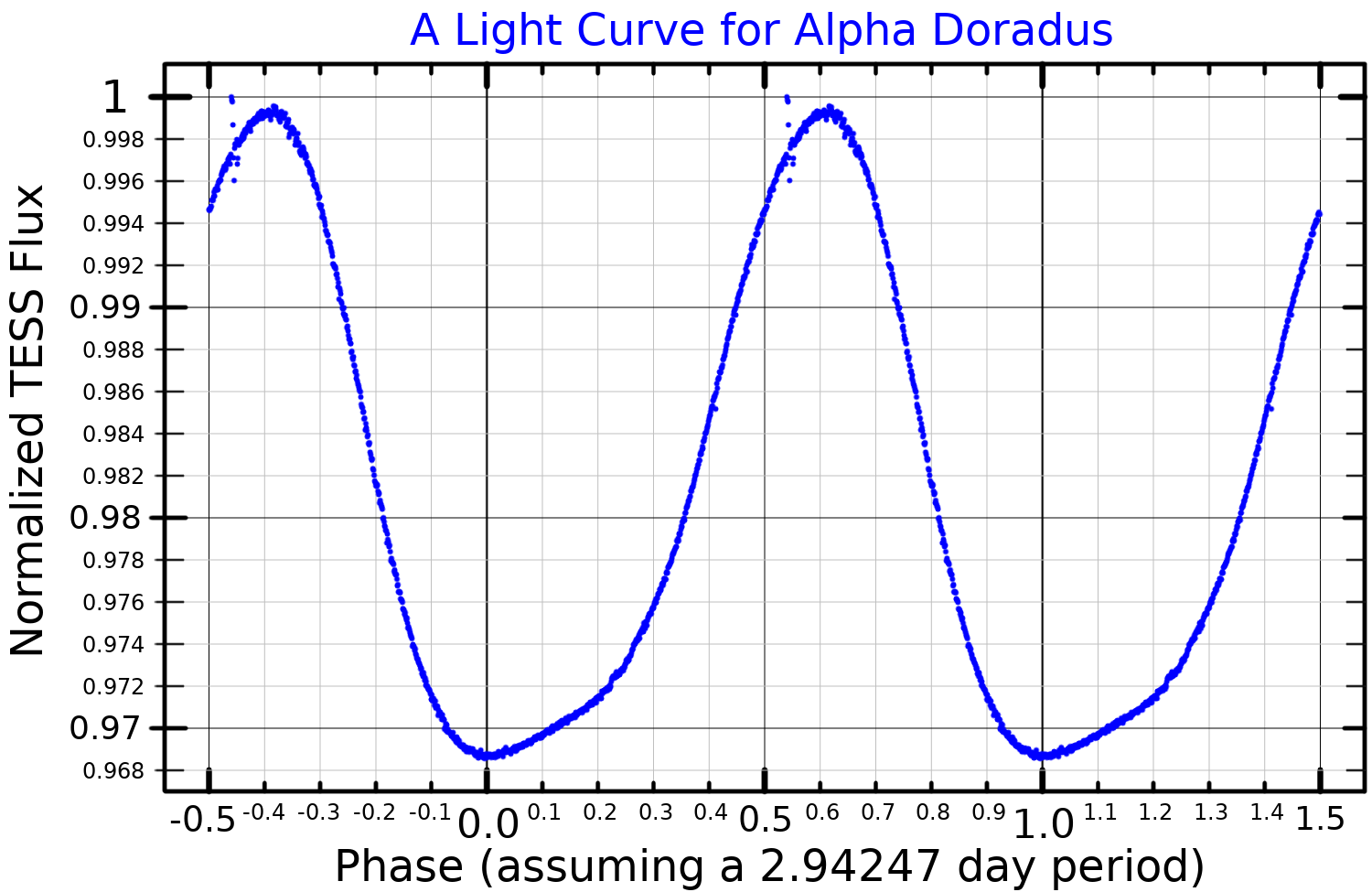|
Alpha2 Canum Venaticorum Variables
An Alpha2 Canum Venaticorum variable (or α2 CVn variable) is a type of variable star. These stars are chemically peculiar main sequence stars of spectral class B8p to A7p. They have strong magnetic fields and strong silicon, strontium, or chromium spectral lines. Their brightness typically varies by 0.01 to 0.1 magnitudes over the course of 0.5 to 160 days. In addition to their intensities, the intensities and profiles of the spectral lines of α2 CVn variables also vary, as do their magnetic fields. The periods of these variations are all equal and are believed to equal the period of rotation of the star. It is thought that they are caused by an inhomogeneous distribution of metals in the atmospheres of these stars, so that the surface of the star varies in brightness from point to point. The type-star which this class is named after is α² Canum Venaticorum, a star in the binary system of Cor Caroli, which is in the northern constellation of Canes Venatici Canes Ven ... [...More Info...] [...Related Items...] OR: [Wikipedia] [Google] [Baidu] |
Variable Star
A variable star is a star whose brightness as seen from Earth (its apparent magnitude) changes with time. This variation may be caused by a change in emitted light or by something partly blocking the light, so variable stars are classified as either: * Intrinsic variables, whose luminosity actually changes; for example, because the star periodically swells and shrinks. * Extrinsic variables, whose apparent changes in brightness are due to changes in the amount of their light that can reach Earth; for example, because the star has an orbiting companion that sometimes eclipses it. Many, possibly most, stars have at least some variation in luminosity: the energy output of the Sun, for example, varies by about 0.1% over an 11-year solar cycle. Discovery An ancient Egyptian calendar of lucky and unlucky days composed some 3,200 years ago may be the oldest preserved historical document of the discovery of a variable star, the eclipsing binary Algol. Of the modern astronomers, th ... [...More Info...] [...Related Items...] OR: [Wikipedia] [Google] [Baidu] |
Cor Caroli
Cor Caroli is a binary star designated Alpha Canum Venaticorum or α Canum Venaticorum. The International Astronomical Union uses the name "Cor Caroli" specifically for the brighter star of the binary. Alpha Canum Venaticorum is the brightest point of light in the northern constellation of Canes Venatici. Nomenclature ''α Canum Venaticorum'', Latinised to ''Alpha Canum Venaticorum'', is the system's Bayer designation. The brighter of the two stars is designated ''α2 Canum Venaticorum'', the fainter ''α1 Canum Venaticorum''. In the western world Alpha Canum Venaticorum had no name until the 17th century, when it was named ''Cor Caroli'', which means "Charles's Heart". There has been some uncertainty whether it was named in honour of King Charles I of England, who was executed in 1649 during the English Civil War, or of his son, Charles II, who restored the English monarchy to the throne in 1660. The name was coined in 1660 by Sir Charles Scarborough, physician to Ch ... [...More Info...] [...Related Items...] OR: [Wikipedia] [Google] [Baidu] |
Beta Hydrae
Beta Hydrae, Latinized from β Hydrae, is a double star in the equatorial constellation of Hydra. Historically, Beta Hydrae was designated 28 Crateris, but the latter fell out of use when the IAU defined the permanent constellation boundaries in 1930. The system is faintly visible to the naked eye with a combined apparent visual magnitude that ranges around 4.29. It is located at a distance of approximately 310 light years from the Sun based on parallax. The double nature of this system was first reported by English astronomer John Herschel in 1834. The brighter primary, designated component A, has an average visual magnitude of 4.67, while the secondary, component B, is of magnitude 5.47. As of 2002, the secondary is located at an angular separation of from the primary, along a position angle of 28.5°. The brighter component is an α2 Canum Venaticorum variable that changes in brightness with a period of 2.344 days and an amplitude of 0.04 in visua ... [...More Info...] [...Related Items...] OR: [Wikipedia] [Google] [Baidu] |
Pisces (constellation)
Pisces is a constellation of the zodiac. Its vast bulk – and main asterism viewed in most European cultures per Greco-Roman antiquity as a distant pair of fishes connected by one cord each that join at an apex – are in the Northern celestial hemisphere. Its old astronomical symbol is (♓︎). Its name is Latin for "fishes". It is between Aquarius, of similar size, to the southwest and Aries, which is smaller, to the east. The ecliptic and the celestial equator intersect within this constellation and in Virgo. This means the sun passes directly overhead of the equator, on average, at approximately this point in the sky, at the March equinox. Features The March equinox is currently located in Pisces, due south of ω Psc, and, due to precession, slowly drifting due west, just below the western fish towards Aquarius. Stars * Alrescha ("the cord"), otherwise Alpha Piscium (α Psc), 309.8 lightyears, class A2, magnitude 3.62. Variable binary star. * Fumalsamakah ... [...More Info...] [...Related Items...] OR: [Wikipedia] [Google] [Baidu] |
Alpha Piscium
Alpha Piscium (α Piscium) is a binary star system in the equatorial constellation of Pisces. Based upon parallax measurements made by the Hipparcos spacecraft, it is about from the Solar System. The two components are designated Alpha Piscium A (officially named Alrescha, the traditional name of the system) and B. Nomenclature ''α Piscium'' ( Latinised to ''Alpha Piscium'') is the star's Bayer designation. The designations of the two components as ''Alpha Piscium A'' and ''B'' derive from the convention used by the Washington Multiplicity Catalog (WMC) for multiple star systems, and adopted by the International Astronomical Union (IAU). The system bore the traditional name ''Alrescha'' (alternatively ''Al Rescha'', ''Alrischa'', ''Alrisha'') derived from the Arabic الرشآء ''al-rishā’'' "the cord" and less commonly ''Kaitain'' and ''Okda'', the latter from the Arabic عقدة ''ʽuqdah'' "knot" (see Ukdah. In 2016, the International Astronomical Union ... [...More Info...] [...Related Items...] OR: [Wikipedia] [Google] [Baidu] |
Dorado
Dorado () is a constellation in the southern sky. It was named in the late 16th century and is now one of the 88 modern constellations. Its name refers to the dolphinfish (''Coryphaena hippurus''), which is known as ''dorado'' in Spanish, although it has also been depicted as a swordfish. Dorado contains most of the Large Magellanic Cloud, the remainder being in the constellation Mensa. The South Ecliptic pole also lies within this constellation. Even though the name Dorado is not Latin but Spanish, astronomers give it the Latin genitive form ''Doradus'' when naming its stars; it is treated (like the adjacent asterism Argo Navis) as a feminine proper name of Greek origin ending in -ō (like ''Io'' or ''Callisto'' or ''Argo''), which have a genitive ending ''-ūs''. History Dorado was one of twelve constellations named by Petrus Plancius from the observations of Pieter Dirkszoon Keyser and Frederick de Houtman. It appeared: * On a celestial globe published in 1597 (or 1598) ... [...More Info...] [...Related Items...] OR: [Wikipedia] [Google] [Baidu] |
Alpha Doradus
Alpha Doradus, Latinized from α Doradus, is the brightest star in the southern constellation of Dorado. The distance to this system, as measured using the parallax method, is about . This is a binary star system with an overall apparent visual magnitude that varies between 3.26 and 3.30, making this one of the brightest binary stars. The system consists of a subgiant star of spectral type B revolving around a giant star with spectral type A in an eccentric orbit with a period of about 12 years. The orbital separation varies from 2 astronomical units at periastron to 17.5 astronomical units at apastron. The primary, α Doradus A, is a chemically peculiar star whose atmosphere displays an abnormally high abundance of silicon, making this an Si star. Alpha Doradus has an optical companion, CCDM J04340-5503C, located 77 arcseconds away along a position angle In astronomy, position angle (usually abbreviated PA) is the convention for measuring angles on ... [...More Info...] [...Related Items...] OR: [Wikipedia] [Google] [Baidu] |
Ursa Major
Ursa Major (; also known as the Great Bear) is a constellation in the northern sky, whose associated mythology likely dates back into prehistory. Its Latin name means "greater (or larger) bear," referring to and contrasting it with nearby Ursa Minor, the lesser bear. In antiquity, it was one of the original 48 constellations listed by Ptolemy in the 2nd century AD, drawing on earlier works by Greek, Egyptian, Babylonian, and Assyrian astronomers. Today it is the third largest of the 88 modern constellations. Ursa Major is primarily known from the asterism of its main seven stars, which has been called the "Big Dipper," "the Wagon," "Charles's Wain," or "the Plough," among other names. In particular, the Big Dipper's stellar configuration mimics the shape of the "Little Dipper." Two of its stars, named Dubhe and Merak ( α Ursae Majoris and β Ursae Majoris), can be used as the navigational pointer towards the place of the current northern pole star, Polaris in Ursa Mino ... [...More Info...] [...Related Items...] OR: [Wikipedia] [Google] [Baidu] |
Epsilon Ursae Majoris
Epsilon Ursae Majoris is a star in the northern constellation of Ursa Major. The designation is Latinised from ε Ursae Majoris and abbreviated Epsilon UMa or ε UMa. It is officially named Alioth . Despite being designated "ε" (epsilon), it is the brightest star in the constellation and at magnitude 1.77 is the thirty-third brightest star in the sky. It is the star in the tail of the bear closest to its body, and thus the star in the handle of the Big Dipper (or Plough) closest to the bowl. It is also a member of the large and diffuse Ursa Major moving group. Historically, the star was frequently used in celestial navigation in the maritime trade, because it is listed as one of the 57 navigational stars. Physical characteristics According to ''Hipparcos'', Epsilon Ursae Majoris is from the Sun. Its spectral type is A1p; the "p" stands for '' peculiar'', as its spectrum is characteristic of an α2 Canum Venaticorum variable. Epsilon U ... [...More Info...] [...Related Items...] OR: [Wikipedia] [Google] [Baidu] |
Cor Caroli
Cor Caroli is a binary star designated Alpha Canum Venaticorum or α Canum Venaticorum. The International Astronomical Union uses the name "Cor Caroli" specifically for the brighter star of the binary. Alpha Canum Venaticorum is the brightest point of light in the northern constellation of Canes Venatici. Nomenclature ''α Canum Venaticorum'', Latinised to ''Alpha Canum Venaticorum'', is the system's Bayer designation. The brighter of the two stars is designated ''α2 Canum Venaticorum'', the fainter ''α1 Canum Venaticorum''. In the western world Alpha Canum Venaticorum had no name until the 17th century, when it was named ''Cor Caroli'', which means "Charles's Heart". There has been some uncertainty whether it was named in honour of King Charles I of England, who was executed in 1649 during the English Civil War, or of his son, Charles II, who restored the English monarchy to the throne in 1660. The name was coined in 1660 by Sir Charles Scarborough, physician to Ch ... [...More Info...] [...Related Items...] OR: [Wikipedia] [Google] [Baidu] |
Canes Venatici
Canes Venatici () is one of the IAU designated constellations, 88 constellations designated by the International Astronomical Union (IAU). It is a small northern constellation that was created by Johannes Hevelius in the 17th century. Its name is Latin for 'hunting dogs', and the constellation is often depicted in illustrations as representing the dogs of Boötes the Herdsman, a neighboring constellation. Cor Caroli is the constellation's brightest star, with an apparent magnitude of 2.9. La Superba (Y CVn) is one of the reddest naked-eye stars and one of the brightest carbon stars. The Whirlpool Galaxy is a spiral galaxy tilted face-on to observers on Earth, and was the first galaxy whose spiral nature was discerned. In addition, quasar Ton 618 has one of the List of most massive black holes, most massive black holes with the mass of 66 billion solar masses. History The stars of Canes Venatici are not bright. In classical times, they were listed by Ptolemy as unfigured sta ... [...More Info...] [...Related Items...] OR: [Wikipedia] [Google] [Baidu] |
Constellation
A constellation is an area on the celestial sphere in which a group of visible stars forms Asterism (astronomy), a perceived pattern or outline, typically representing an animal, mythological subject, or inanimate object. The origins of the earliest constellations likely go back to prehistory. People used them to relate stories of their beliefs, experiences, creation myth, creation, or mythology. Different cultures and countries adopted their own constellations, some of which lasted into the early 20th century before today's constellations were internationally recognized. The recognition of constellations has changed significantly over time. Many changed in size or shape. Some became popular, only to drop into obscurity. Some were limited to a single culture or nation. The 48 traditional Western constellations are Greek. They are given in Aratus' work ''Phenomena'' and Ptolemy's ''Almagest'', though their origin probably predates these works by several centuries. Constellation ... [...More Info...] [...Related Items...] OR: [Wikipedia] [Google] [Baidu] |









